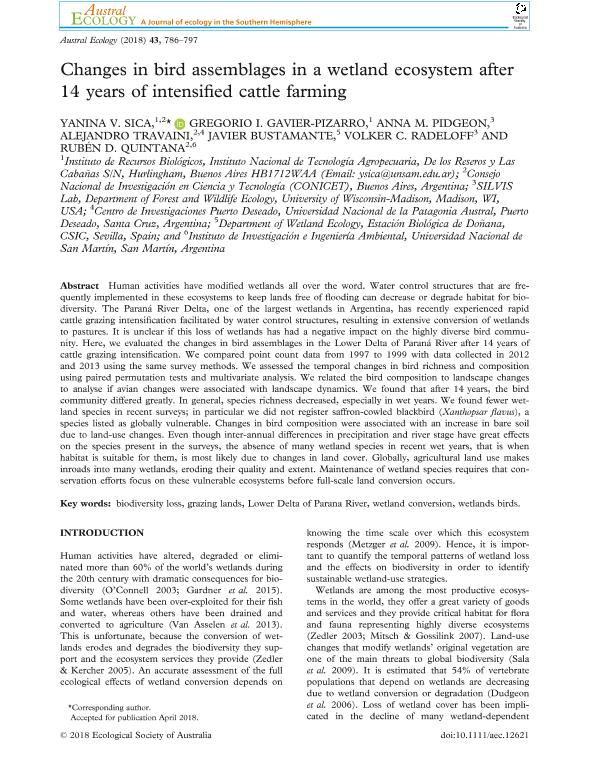Mostrar el registro sencillo del ítem
dc.contributor.author
Sica, Yanina Vanesa

dc.contributor.author
Gavier Pizarro, Gregorio

dc.contributor.author
Pidgeon, Anne
dc.contributor.author
Travaini, Alejandro

dc.contributor.author
Bustamante, Javier
dc.contributor.author
Radeloff, Volker

dc.contributor.author
Quintana, Ruben Dario

dc.date.available
2022-10-21T11:12:43Z
dc.date.issued
2018-11
dc.identifier.citation
Sica, Yanina Vanesa; Gavier Pizarro, Gregorio; Pidgeon, Anne; Travaini, Alejandro; Bustamante, Javier; et al.; Changes in bird assemblages in a wetland ecosystem after 14 years of intensified cattle farming; Wiley Blackwell Publishing, Inc; Austral Ecology; 43; 7; 11-2018; 786-797
dc.identifier.issn
1442-9985
dc.identifier.uri
http://hdl.handle.net/11336/174287
dc.description.abstract
Human activities have modified wetlands all over the word. Water control structures that are frequently implemented in these ecosystems to keep lands free of flooding can decrease or degrade habitat for biodiversity. The Paraná River Delta, one of the largest wetlands in Argentina, has recently experienced rapid cattle grazing intensification facilitated by water control structures, resulting in extensive conversion of wetlands to pastures. It is unclear if this loss of wetlands has had a negative impact on the highly diverse bird community. Here, we evaluated the changes in bird assemblages in the Lower Delta of Paraná River after 14 years of cattle grazing intensification. We compared point count data from 1997 to 1999 with data collected in 2012 and 2013 using the same survey methods. We assessed the temporal changes in bird richness and composition using paired permutation tests and multivariate analysis. We related the bird composition to landscape changes to analyse if avian changes were associated with landscape dynamics. We found that after 14 years, the bird community differed greatly. In general, species richness decreased, especially in wet years. We found fewer wetland species in recent surveys; in particular we did not register saffron-cowled blackbird (Xanthopsar flavus), a species listed as globally vulnerable. Changes in bird composition were associated with an increase in bare soil due to land-use changes. Even though inter-annual differences in precipitation and river stage have great effects on the species present in the surveys, the absence of many wetland species in recent wet years, that is when habitat is suitable for them, is most likely due to changes in land cover. Globally, agricultural land use makes inroads into many wetlands, eroding their quality and extent. Maintenance of wetland species requires that conservation efforts focus on these vulnerable ecosystems before full-scale land conversion occurs.
dc.format
application/pdf
dc.language.iso
eng
dc.publisher
Wiley Blackwell Publishing, Inc

dc.rights
info:eu-repo/semantics/openAccess
dc.rights.uri
https://creativecommons.org/licenses/by-nc-sa/2.5/ar/
dc.subject
BIODIVERSITY LOSS
dc.subject
GRAZING LANDS
dc.subject
LOWER DELTA OF PARANA RIVER
dc.subject
WETLAND CONVERSION
dc.subject
WETLANDS BIRDS
dc.subject.classification
Ecología

dc.subject.classification
Ciencias Biológicas

dc.subject.classification
CIENCIAS NATURALES Y EXACTAS

dc.subject.classification
Zoología, Ornitología, Entomología, Etología

dc.subject.classification
Ciencias Biológicas

dc.subject.classification
CIENCIAS NATURALES Y EXACTAS

dc.subject.classification
Conservación de la Biodiversidad

dc.subject.classification
Ciencias Biológicas

dc.subject.classification
CIENCIAS NATURALES Y EXACTAS

dc.title
Changes in bird assemblages in a wetland ecosystem after 14 years of intensified cattle farming
dc.type
info:eu-repo/semantics/article
dc.type
info:ar-repo/semantics/artículo
dc.type
info:eu-repo/semantics/publishedVersion
dc.date.updated
2022-09-28T17:50:53Z
dc.journal.volume
43
dc.journal.number
7
dc.journal.pagination
786-797
dc.journal.pais
Reino Unido

dc.journal.ciudad
Londres
dc.description.fil
Fil: Sica, Yanina Vanesa. Consejo Nacional de Investigaciones Científicas y Técnicas; Argentina. Instituto Nacional de Tecnología Agropecuaria. Centro de Investigación de Recursos Naturales. Instituto de Recursos Biológicos; Argentina
dc.description.fil
Fil: Gavier Pizarro, Gregorio. Instituto Nacional de Tecnología Agropecuaria. Centro de Investigación de Recursos Naturales. Instituto de Recursos Biológicos; Argentina. Consejo Nacional de Investigaciones Científicas y Técnicas; Argentina
dc.description.fil
Fil: Pidgeon, Anne. No especifíca;
dc.description.fil
Fil: Travaini, Alejandro. Consejo Nacional de Investigaciones Científicas y Técnicas; Argentina. Universidad Nacional de la Patagonia Austral. Unidad Académica Caleta Olivia. Centro de Investigaciones Puerto Deseado; Argentina
dc.description.fil
Fil: Bustamante, Javier. Consejo Superior de Investigaciones Científicas; España
dc.description.fil
Fil: Radeloff, Volker. No especifíca;
dc.description.fil
Fil: Quintana, Ruben Dario. Universidad Nacional de San Martín. Instituto de Investigación e Ingeniería Ambiental. - Consejo Nacional de Investigaciones Científicas y Técnicas. Oficina de Coordinación Administrativa Parque Centenario. Instituto de Investigación e Ingeniería Ambiental; Argentina
dc.journal.title
Austral Ecology

dc.relation.alternativeid
info:eu-repo/semantics/altIdentifier/doi/http://dx.doi.org/10.1111/aec.12621
Archivos asociados
